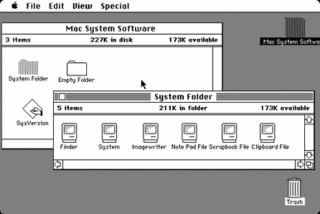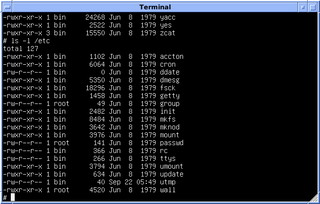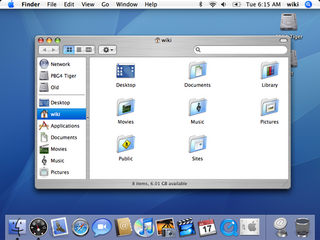
An operating system (OS) is system software that manages computer hardware, software resources, and provides common services for computer programs.
The Single UNIX Specification (SUS) is the collective name of a family of standards for computer operating systems, compliance with which is required to qualify for using the "UNIX" trademark. The core specifications of the SUS are developed and maintained by the Austin Group, which is a joint working group of IEEE, ISO JTC 1 SC22 and The Open Group. If an operating system is submitted to The Open Group for certification, and passes conformance tests, then it is deemed to be compliant with a UNIX standard such as UNIX 98 or UNIX 03.
Darwin is an open-source Unix-like operating system first released by Apple Inc. in 2000. It is composed of code developed by Apple, as well as code derived from NeXTSTEP, BSD, Mach, and other free software projects.
The history of macOS, Apple's current Mac operating system originally named Mac OS X until 2012 and then OS X until 2016, began with the company's project to replace its "classic" Mac OS. That system, up to and including its final release Mac OS 9, was a direct descendant of the operating system Apple had used in its Macintosh computers since their introduction in 1984. However, the current macOS is a Unix operating system built on technology that had been developed at NeXT from the 1980s until Apple purchased the company in early 1997.

A kernel panic is a safety measure taken by an operating system's kernel upon detecting an internal fatal error in which it either is unable to safely recover or cannot have the system continue to run without having a much higher risk of major data loss. The term is largely specific to Unix and Unix-like systems. For Microsoft Windows operating systems the equivalent term is "Stop error", resulting in a bug check screen that presents the bug check code on a blue background in early versions of Windows, or on a green background on the Xbox One platform as well as in some Windows 10 builds.

For computer file systems, fdisk is a command-line utility that provides disk partitioning functions. It is available in DOS, DR FlexOS, IBM OS/2, and Microsoft Windows operating systems, and in certain ports of FreeBSD, NetBSD, OpenBSD, DragonFly BSD and macOS for compatibility reasons. In versions of the Windows NT operating system line from Windows 2000 onwards, fdisk is replaced by a more advanced tool called diskpart. Similar utilities exist for Unix-like systems, for example, BSD disklabel.

Mac OS X Jaguar is the third major release of Mac OS X, Apple's desktop and server operating system. It superseded Mac OS X 10.1 and preceded Mac OS X Panther. The operating system was released on August 23, 2002 either for single-computer installations, and in a “family pack,” which allowed five installations on separate computers in one household. The operating system was generally well received by most Mac users as a large step forward in the areas of stability, general speed enhancements, compatibility with other flavors of Unix and the lineup of both graphical and terminal applications available; however, many critics, such as Amazon.com users, still claimed that significant user interface speed issues existed and that the operating system was still a big step down from Mac OS 9.

In multitasking computer operating systems, a daemon is a computer program that runs as a background process, rather than being under the direct control of an interactive user. Traditionally, the process names of a daemon end with the letter d, for clarification that the process is in fact a daemon, and for differentiation between a daemon and a normal computer program. For example, syslogd is the daemon that implements the system logging facility, and sshd is a daemon that serves incoming SSH connections.

XNU is the computer operating system kernel developed at Apple Inc. since December 1996 for use in the macOS operating system and released as free and open-source software as part of the Darwin operating system, which is the basis for the Apple TV Software, iOS, iPadOS, watchOS, tvOS, and audioOS operating systems. XNU is an abbreviation of X is Not Unix.

Mac OS X Leopard is the sixth major release of Mac OS X, Apple's desktop and server operating system for Macintosh computers. Leopard was released on October 26, 2007 as the successor of Mac OS X 10.4 Tiger, and is available in two editions: a desktop version suitable for personal computers, and a server version, Mac OS X Server. It retailed for $129 for the desktop version and $499 for Server. Leopard was superseded by Snow Leopard. Leopard is the final version of Mac OS X to support the PowerPC architecture as Snow Leopard functions solely on Intel based Macs.

A Hackintosh, is a computer that runs macOS on a device not authorized by Apple. "Hackintoshing" began as a result of Apple's 2005 transition to Intel Processors, away from PowerPC. Since 2005, Mac computers use the same x86-64 computer architecture as other computer manufacturers, maintaining binary-code compatibility. Hackintosh laptops are sometimes referred to as "Hackbooks".

The architecture of macOS describes the layers of the operating system that is the culmination of Apple Inc.'s decade-long research and development process to replace the classic Mac OS.
In computing, a dynamic linker is the part of an operating system that loads and links the shared libraries needed by an executable when it is executed, by copying the content of libraries from persistent storage to RAM, filling jump tables and relocating pointers. The specific operating system and executable format determine how the dynamic linker functions and how it is implemented.

The Macintosh is a family of personal computers designed, manufactured and sold by Apple Inc. since January 1984.

The family of Macintosh operating systems developed by Apple Inc. includes the graphical user interface-based operating systems it has designed for use with its Macintosh series of personal computers since 1984, as well as the related system software it once created for compatible third-party systems.

BootX is a software-based bootloader designed and developed by Apple Inc. for use on the company's Macintosh computer range. BootX is used to prepare the computer for use, by loading all required device drivers and then starting-up Mac OS X by booting the kernel on all PowerPC Macintoshes running the Mac OS X 10.2 operating system or later versions.
ptrace is a system call found in Unix and several Unix-like operating systems. By using ptrace one process can control another, enabling the controller to inspect and manipulate the internal state of its target. ptrace is used by debuggers and other code-analysis tools, mostly as aids to software development.

NextBSD is an operating system initially based on the trunk version of FreeBSD as of August 2015. It is a fork of FreeBSD which implements new features developed on branches but not yet implemented in FreeBSD. As of 2019 the website seems defunct, and the later commits on github date from July, 2016.














